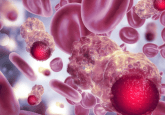Novel diagnostic biomarker for acute adult T-cell leukemia discovered

A study conducted by researchers based at the University of the Ryukyus (Nishihara, Japan) and NEC Corporation (Tokyo, Japan) has identified a novel diagnostic biomarker for acute adult T-cell leukemia/lymphoma (ATL). Quantitative analysis of the novel diagnostic biomarker levels may facilitate the early diagnosis of ATL.
ATL – a mature T-cell neoplasm – is associated with human T-cell leukemia virus type-1 (HTLV-1). Japan has one of the largest populations of HTLV-1 carriers, with an estimated total of over 1 million. As a result, incidence rates of ATL in Japan are some of the highest in the world. Only 5% of HTLV-1 carriers display the clinical features of ATL during their lifetimes, with the large majority remaining asymptomatic.
At present, prognosis for the acute and lymphoma subtypes is poor, with a median survival time between 8 and 10 months. Currently, ATL is known to increase a variety of plasma proteins, however no change specific to ATL has been identified and therefore there are no clinical predictors for ATL onset.
Scientists from the University of the Ryukyus and NEC Corporation entered a collaboration to identify a new biomarker that could facilitate the early detection of ACL. The results of the research, published in the American Society of Hematology’s Blood Advances, detail a comprehensive blood-based proteomic analysis of HTLV-1 and ATL samples from the Okinawa Biobank (Japan). By comparing results from asymptomatic carriers and ATL patients, scientists identified elevated expression of soluble tumor necrosis factor receptor 2 (sTNFR2).
You might also like…
Elevated levels of sTNFR2 were identified from a proteomic analysis which assessed the expression levels of 1,305 plasma proteins in samples from 40 asymptomatic carriers and 40 ATL patients. The initial proteomic analysis identified 333 proteins with significant differences in expression levels between the two subject groups. Further ELISA analysis highlighted vastly different expression levels of sTNFR2 between the two groups.
The researchers believe the results of this study indicate the potential clinical utility of sTNFR2 as a novel diagnostic biomarker for acute ATL. Future research is likely to further examine the significance of elevated STNFR2 in ATL onset prediction and investigate the mechanism by which tumor necrosis factor 2 is shed from the surface of cells as a potential therapeutic route.
Sources: Guerrero CLH, Yamashita Y, Miyara M. Proteomic profiling of HTLV-1 carriers and ATL patients reveals sTNFR2 as a novel diagnostic biomarker for acute ATL. Blood Adv. 4(6) 1065–1071 (2020); www.nec.com/en/press/202003/global_20200323_02.html





